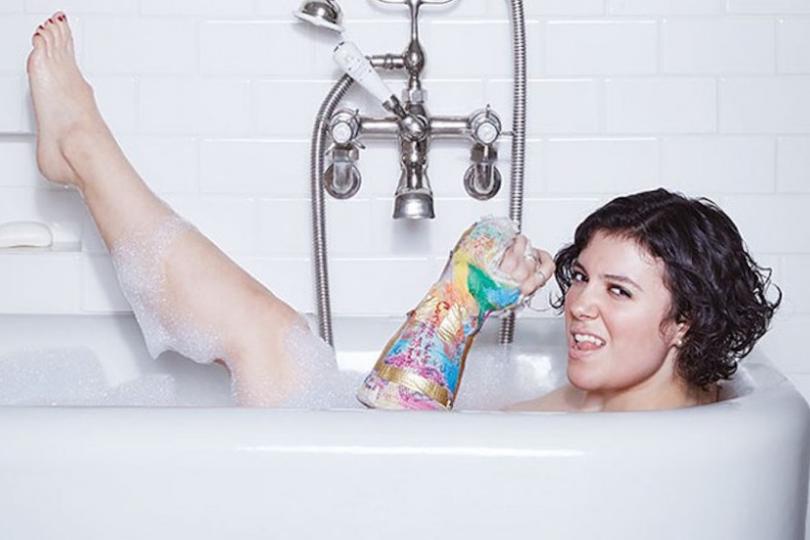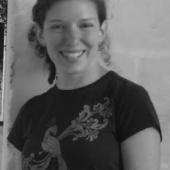Intimacy

After getting in a bike accident in Brooklyn’s terrifying Grand Army Plaza and breaking bones in her left hand, Siobhan O’Loughlin found herself in a particularly vulnerable position. Worried about getting her cast wet in the shower – but living in an apartment without a bathtub – she spent a lot of time in her friends’ apartments, borrowing both their bathrooms and their help with tasks, like washing her hair, that had suddenly become much more difficult to do one-handed.
Bathing is usually an intensely private act, as is everything else that happens in a bathroom. Apart from public restrooms, I don’t know of any established social norms around being in bathrooms with groups of people. So when Siobhan turned her bathing experience into a play, Broken Bone Bathtub, she also created a unique opportunity to create social interaction where none normally exists.
The experience looks like this: you show up at a stranger’s home and socialize with around seven other people in a living room. This is familiar. Small-talk is an uncomfortable, but usually fairly painless, part of being a human in the world. But then you get led upstairs, to a bathroom filled with benches and chairs, where Siobhan is sitting in the tub covered in a thick layer of bubble bath. (If you’re the type to worry about nudity, the slowly dissipating bubbles might make you nervous, but over the roughly 50-minute show, there are always enough.)
Scent-o-rama
First of all, it smells wonderful, and the steamy bathroom is a lovely place to sit on a cool autumn night. (I was jealous of Siobhan and started to consider buying some bubble bath for myself.) But the side benefit, both of the setting and the proximity both to Siobhan and to the other audience members, is of being completely disarmed. It turns out that it is not only vulnerable to be the one naked in a bathtub; it is also vulnerable to be in a bathroom with a naked person and seven strangers, without any social codes to tell you how to act.
And Siobhan’s performance is about exactly that level of vulnerability. In her immediately personable, engaging way, she looks us in the eyes and tells us about her accident, but she also asks us to be more than just passive observers. This is half performance, half facilitated discussion – first about safe topics (have you ever broken a bone?), and then, as the audience gets more comfortable, about the kinds of stories that go beyond small talk (have you ever cried in public?). Through this shared sense of vulnerability, Siobhan creates a temporary community around her tub.
One of the most pleasing parts of the whole experience is how neatly the show’s form reflects its function. In telling her story of injury and healing, Siobhan’s overall message is about the connections that can be made through human touch. But she is also a self-identified activist interested in issues from composting to the deaths of Michael Brown and Eric Garner, and she ties together the need for human kindness and the larger work of community building. “Broken Bone Bathtub” is a way of bringing macro-level community engagement into the micro-level community created in a stranger’s home.
Bathroom privileges
Because Siobhan is so engaged with political issues, her show got me thinking about the location of the bathroom and the composition of audience around me. I was grateful at her acknowledgement of her own privilege, because the particular bathroom I saw her in – a large, gracefully-decorated room with a massive jacuzzi tub that one fellow spectator joked was like a thrust stage – could not have been more indicative of a particular social circle and lifestyle. I wondered whether potential non-white, non-middle class audiences might be daunted to knock at the door of the house hosting the show, and whether there would have been a different atmosphere in the living room if we had not all been of a similar demographic. The safe space created through steam and nice-smelling bubbles might not have felt as safe to all possible spectators.
This is not a criticism of Siobhan’s show itself, as she has minimal control over who comes to see it, but rather a recognition of Siobhan’s ability to create community. She does so well at building connections that I kept thinking that “Broken Bone Bathtub” could exemplify its goals even more if it were able to attract a more diverse crowd. It is relatively easy for people to reach out to someone who looks like them, but how much more powerful would it be to see her generate this level of kindness and humanity among people who would not normally live in the same neighborhoods or walk down the same streets?
Siobhan’s openness, trust, and engaging performance make it easy to enter her world. “Broken Bone Bathtub” is a unique experience that asks you to listen not only to the star of the show, but to your fellow audience members; walking out of the house, it feels good to have been part of this hour-long community. The weirder this whole idea seems to you, the more I would encourage you to do it – Siobhan’s bathtub storytelling creates a strange and unique kind of magic.




